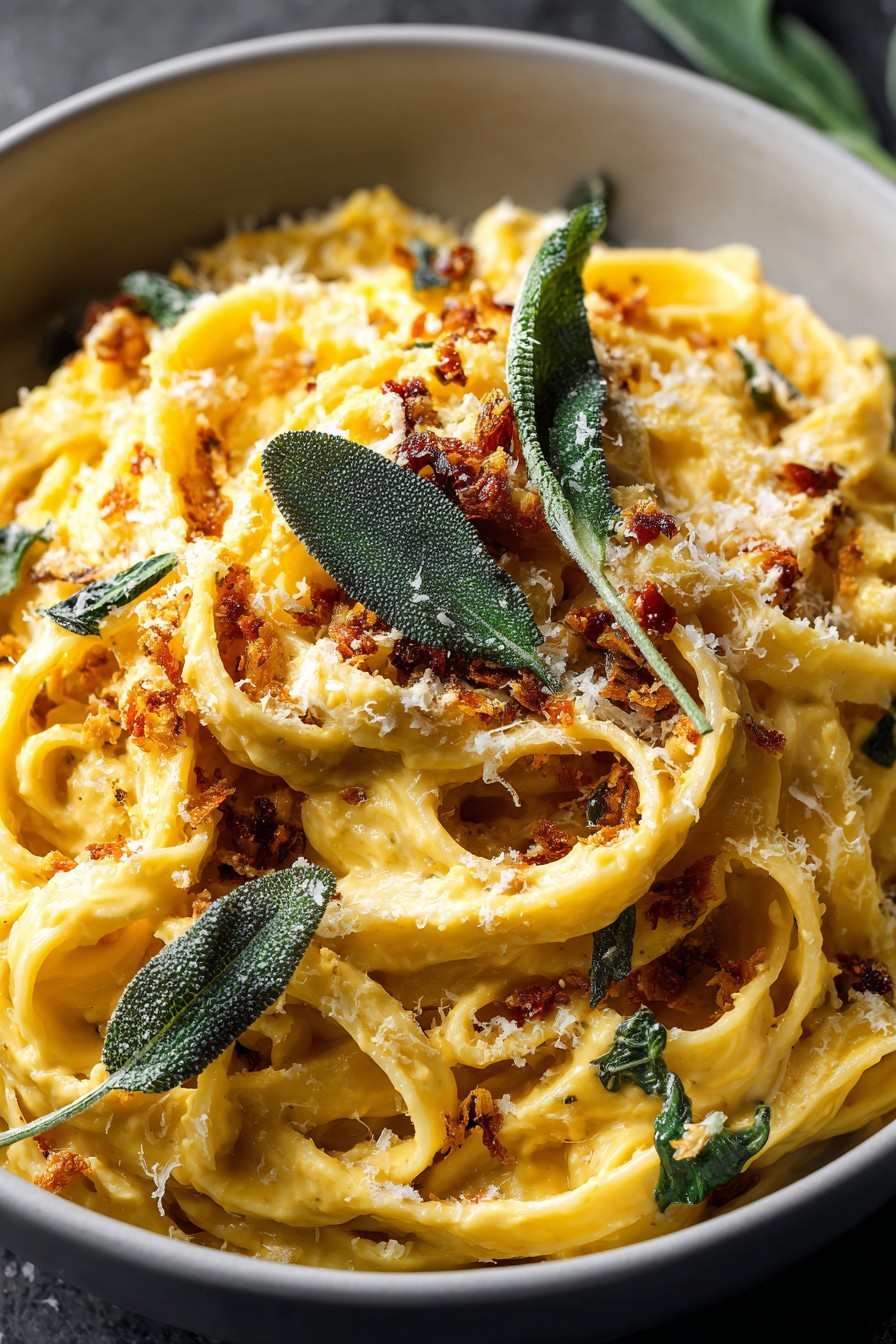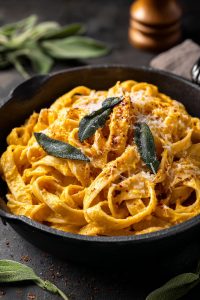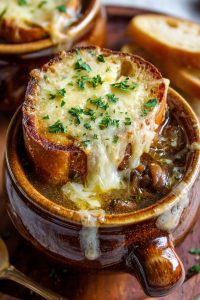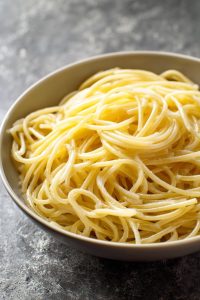Zestful autumn evenings call for comforting bowls of pasta that celebrate seasonal flavors. This pumpkin sage pasta delivers creamy satisfaction with minimal effort, transforming simple ingredients into an elegant weeknight dinner. The combination of earthy pumpkin and aromatic sage creates a dish that feels both rustic and refined.
Why This Recipe Works
- The sauce achieves perfect creaminess without heavy cream by using pumpkin puree and pasta water, creating a lighter yet satisfying texture that coats every noodle evenly
- Toasting fresh sage leaves in butter develops complex nutty and earthy flavors that form the foundation of the sauce, transforming simple herbs into something extraordinary
- Using canned pumpkin puree ensures consistent results year-round while saving significant preparation time compared to roasting fresh pumpkin
- The addition of nutmeg and black pepper provides subtle warmth that complements the pumpkin without overwhelming the delicate sage flavor profile
- Reserving pasta water before draining allows you to adjust the sauce consistency perfectly, creating a silky emulsion that clings to the pasta beautifully
Ingredients
- 1 pound fettuccine pasta
- 4 tablespoons unsalted butter
- 20 fresh sage leaves
- 3 garlic cloves, minced
- 1 (15-ounce) can pumpkin puree
- 1 cup vegetable broth
- 1/2 cup grated Parmesan cheese
- 1/4 teaspoon ground nutmeg
- 1/2 teaspoon black pepper
- 1 teaspoon salt
- 1/2 cup reserved pasta water
Equipment Needed
- Large pot for boiling pasta
- Large skillet or sauté pan
- Colander for draining pasta
- Measuring cups and spoons
- Chef’s knife and cutting board
- Wooden spoon or spatula
- Ladle or measuring cup for pasta water
Instructions

Prepare the Pasta Base
Bring 4 quarts of water to a rolling boil in a large pot over high heat. Add 1 tablespoon of salt to the boiling water, then carefully add 1 pound of fettuccine pasta. Cook according to package directions until al dente, which typically takes 8-10 minutes. Before draining, carefully reserve 1/2 cup of the starchy pasta water using a ladle or measuring cup. This water contains dissolved starch that will help emulsify and thicken your sauce later. Drain the remaining pasta in a colander but do not rinse, as the surface starch helps the sauce adhere to the noodles. Set the drained pasta aside while you prepare the sauce components.
Create the Sage Butter Foundation
Place a large skillet over medium heat and add 4 tablespoons of unsalted butter. Allow the butter to melt completely and begin to foam slightly, which should take about 2 minutes. Carefully add 20 fresh sage leaves to the melted butter, arranging them in a single layer if possible. Cook the sage leaves for 2-3 minutes until they become crisp and darken slightly, flipping them once halfway through. The butter will develop golden brown specks and release a nutty aroma. Remove the crispy sage leaves from the skillet and set them aside on a paper towel-lined plate for garnishing later. The infused butter remaining in the skillet now contains the essential sage flavor that will permeate your entire sauce.
Build the Pumpkin Sauce Base
Reduce the heat to medium-low and add 3 minced garlic cloves to the sage-infused butter remaining in the skillet. Sauté the garlic for exactly 1 minute until fragrant but not browned, stirring constantly with a wooden spoon. Add 1 (15-ounce) can of pumpkin puree to the skillet, followed by 1 cup of vegetable broth. Whisk continuously until the mixture becomes smooth and well combined, which should take about 2 minutes. Stir in 1/4 teaspoon of ground nutmeg, 1/2 teaspoon of black pepper, and 1 teaspoon of salt. Continue cooking the sauce for 3-4 minutes, allowing the flavors to meld together while stirring occasionally to prevent sticking.
Combine Pasta and Sauce
Add the drained fettuccine directly to the skillet with the pumpkin sauce. Use tongs to toss the pasta thoroughly, ensuring each strand becomes coated with the sauce. Begin adding the reserved pasta water 2 tablespoons at a time, continuing to toss the pasta between each addition. The starch in the pasta water will help create a silky, emulsified sauce that clings perfectly to the noodles. Add just enough pasta water to achieve your desired sauce consistency—typically about 1/2 cup total. The sauce should coat the pasta evenly without pooling at the bottom of the skillet.
Finish and Serve the Dish
Remove the skillet from heat and sprinkle 1/2 cup of grated Parmesan cheese over the pasta. Toss vigorously to incorporate the cheese, which will melt into the sauce and add richness. Taste and adjust seasoning with additional salt or pepper if needed. Divide the pasta among serving bowls and top each portion with the reserved crispy sage leaves. Serve immediately while hot, as the pasta continues to absorb liquid over time. The dish is best enjoyed fresh, but any leftovers can be stored in an airtight container in the refrigerator for up to 3 days.
Tips and Tricks
For optimal pasta texture, always cook your noodles in generously salted water—about 1 tablespoon of salt per 4 quarts of water. The salt seasons the pasta from within rather than just sitting on the surface. When testing for doneness, fish out a single strand about 2 minutes before the package’s suggested cooking time ends. The pasta should offer slight resistance when bitten, known as al dente texture, since it will continue cooking slightly when combined with the hot sauce.
When working with canned pumpkin puree, be certain you’re using pure pumpkin and not pumpkin pie filling, which contains added sugars and spices. If your pumpkin puree appears watery, you can drain it in a fine-mesh strainer for 15 minutes before using to concentrate the flavor and texture. For enhanced depth, consider roasting your own pumpkin: cut a sugar pumpkin in half, remove seeds, roast cut-side down at 400°F for 45 minutes, then scoop out and puree the flesh.
The crispy sage leaves can be prepared in advance and stored in an airtight container at room temperature for up to 2 days. For extra crispiness, ensure your sage leaves are completely dry before adding to the butter, and don’t overcrowd the pan. If you prefer softer sage flavor, you can chop fresh sage and add it directly to the sauce rather than crisping whole leaves, though you’ll miss the textural contrast.
For dairy-free adaptation, substitute the butter with olive oil or vegan butter, and use nutritional yeast instead of Parmesan cheese. The sauce will still emulsify properly thanks to the starchy pasta water. If you prefer a richer sauce, you can add 1/4 cup of heavy cream or coconut milk during the final tossing stage, though the recipe works perfectly without it.
When reheating leftovers, add a tablespoon of water or broth to help loosen the sauce, as pasta continues to absorb liquid when refrigerated. Gently reheat in a skillet over medium-low heat rather than microwaving, which can make the pasta gummy. For meal prep, you can make the sauce base up to 3 days in advance and store it separately from the cooked pasta, then combine when ready to serve.
Recipe Variations
- For protein addition, sauté 1 pound of Italian sausage or diced chicken breast before making the sage butter. Remove the cooked protein from the skillet, then proceed with the recipe as written, adding the protein back when you combine the pasta and sauce. The savory meat complements the sweet pumpkin beautifully and makes the dish more substantial for heartier appetites.
- Create a roasted vegetable version by tossing 2 cups of cubed butternut squash or Brussels sprouts with olive oil, salt, and pepper. Roast at 425°F for 20-25 minutes until tender and slightly caramelized. Add these roasted vegetables to the pasta during the final tossing stage for additional texture and natural sweetness that enhances the autumn theme.
- For a creamier texture, blend the sauce base with 1/2 cup of soaked cashews or 1/4 cup of heavy cream before combining with the pasta. This creates an ultra-silky consistency that feels more indulgent while still maintaining the pumpkin flavor as the star. The cashew version works particularly well for vegan adaptations.
- Transform into a baked pasta dish by transferring the completed pasta to a baking dish, topping with breadcrumbs mixed with Parmesan cheese, and baking at 375°F for 15-20 minutes until bubbly and golden. This variation works well for entertaining as it can be prepared ahead and holds well for serving multiple people simultaneously.
- Incorporate different pasta shapes like rigatoni, penne, or farfalle that capture the sauce in their crevices. Whole wheat or chickpea pasta alternatives work well, though you may need slightly more pasta water as these varieties absorb more liquid. Gluten-free pasta also adapts beautifully to this recipe with minimal adjustments.
Frequently Asked Questions
Can I use fresh pumpkin instead of canned puree?
Yes, fresh pumpkin works well but requires additional preparation time. Select a small sugar pumpkin (about 2-3 pounds), cut it in half, and remove the seeds and stringy pulp. Roast the halves cut-side down on a baking sheet at 400°F for 45-60 minutes until the flesh is completely tender when pierced with a fork. Scoop the cooked pumpkin from the skin and puree in a food processor or blender until smooth. Fresh pumpkin puree tends to be more watery than canned, so you may need to drain it in a cheesecloth-lined strainer for 30 minutes before using. The flavor will be slightly brighter and less concentrated than canned puree.
What can I substitute for sage if I don’t have any?
While sage provides the distinctive flavor profile, several herbs can work as substitutes depending on what you have available. Fresh thyme offers earthy notes that complement pumpkin well—use 2 tablespoons of fresh thyme leaves added directly to the sauce. Rosemary provides a pine-like aroma—use 1 tablespoon finely chopped fresh rosemary added with the garlic. For a different direction, try 1/4 cup fresh parsley with 1 teaspoon dried oregano for an Italian herb variation. In emergencies, 2 teaspoons of dried sage can substitute for fresh, though the flavor will be more muted and slightly musty compared to fresh leaves.
How can I make this recipe vegan?
This recipe adapts easily to vegan preferences with simple substitutions. Replace the butter with an equal amount of olive oil or vegan butter alternative. Use vegetable broth instead of chicken broth if your recipe typically includes it. Substitute the Parmesan cheese with 1/4 cup nutritional yeast, which provides the cheesy flavor, or use a commercial vegan Parmesan alternative. For added richness, blend 1/4 cup of raw cashews (soaked for 2 hours then drained) with the pumpkin puree until completely smooth. The starchy pasta water will still help create a creamy emulsion without dairy products.
Why is my sauce too thin or watery?
A thin sauce typically results from insufficient reduction or too much liquid added. If your sauce seems watery after combining with pasta, return the skillet to medium heat and cook for 2-3 additional minutes, stirring constantly, to evaporate excess moisture. The sauce should thicken as the starch from the pasta water expands with heat. If it remains too thin, create a slurry by mixing 1 teaspoon of cornstarch with 1 tablespoon of cold water, then stir this into the sauce and cook for 1 minute until thickened. Next time, remember to reserve pasta water but add it gradually until you achieve the desired consistency rather than pouring it all in at once.
Can I prepare this dish ahead of time?
You can prepare components in advance but the dish is best served fresh. The sauce base (without pasta water) can be made up to 3 days ahead and refrigerated in an airtight container. The crispy sage leaves can be prepared 2 days ahead and stored at room temperature. Cook the pasta fresh when ready to serve, as refrigerated cooked pasta becomes gummy and doesn’t reheat well. If you must prepare completely ahead, undercook the pasta by 2 minutes, combine with the sauce, and store refrigerated. When reheating, add a splash of water or broth and warm gently in a skillet, tossing frequently until heated through.
Summary
This pumpkin sage pasta combines seasonal flavors in a creamy, satisfying dish that comes together quickly. The method relies on technique rather than complexity, with toasted sage, starchy pasta water, and balanced seasoning creating restaurant-quality results at home. Perfect for autumn evenings when you want comfort food that feels special without requiring hours in the kitchen.



